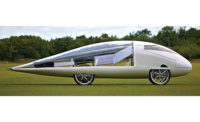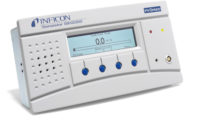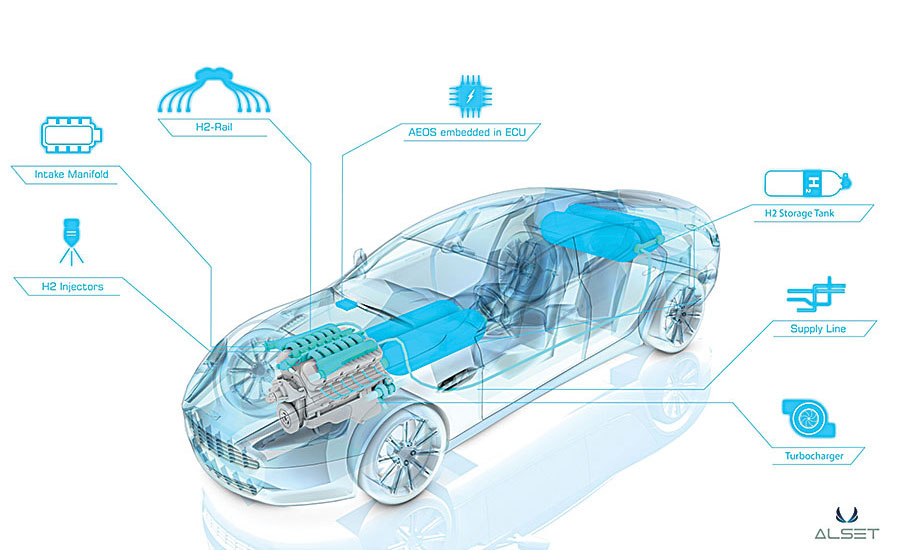Leak Tester Inspects Hydrogen-Powered Race Car

Engineers first tested vehicle components using the instrument’s analysis mode and a sniffer probe to determine if any hydrogen was escaping. If that was the case, the device produced an auditory signal and the tester shifted to leak detection mode. Photo courtesy Inficon Deutschland GmbH

An Aston Martin Rapide S, the first race car with a hydrogen combustion engine, recently competed in one of the most challenging 24-hour races in the world, the 41st ADAC Zurich race. Photo courtesy Inficon Deutschland GmbH

To ensure safety, engineers leak-tested every component of the hydrogen-powered race car. Photo courtesy Inficon Deutschland GmbH

The Sensistor ISH2000’s sensor can pinpoint small and major leaks within a short time and is ready to use again after just a few seconds. Photo courtesy Inficon Deutschland GmbH

Instead of locating leaks and providing simple “good” or “no good” statements, the Sensistor ISH2000C provides a precise leak rate and size. Photo courtesy Inficon Deutschland GmbH





An Aston Martin Rapide S, the first race car with a hydrogen combustion engine, recently competed in one of the most challenging 24-hour races in the world. The 41st ADAC Zurich race clearly demonstrated the reliability of the Rapide S hydrogen technology.
Along with seven partners and more than 35 suppliers, Alset GmbH took the lead in developing, installing and testing the Aston Martin’s drive unit, as well as the hydrogen hybrid storage and supply
system.
The Rapide S finished the endurance race in 114th place—an accomplishment that culminated more than 12 months of work and proved that a hydrogen-powered combustion engine could withstand some of the most difficult conditions possible.
As part of the development process and before competing in the ultimate test of a 24-hour endurance race, Alset needed to check for leaks in the vehicle’s hydrogen combustion system.
When using highly flammable gases such as oxygen and hydrogen, it is crucial to keep the fuels separate, since hydrogen is supposed to develop its full effect inside the engine, not outside of it. To ensure the fuels would not combine prematurely, Alset used Inficon’s Sensistor ISH2000 leak detection technology to test all the components.
Hydrogen Power
The race car has four hydrogen tanks. Each is equipped with fill and discharge lines, pressure regulating units, hydrogen rails and injection valves, and electronic hydrogen and engine control units.
“Developing a functional hydrogen hybrid drive is not all that difficult, in principle,” notes Gonzalo Auil, regional manager at Alset, which is based in Graz, Austria. “The challenge, however, was in the details. Our goal was to achieve optimal combustion during every form of operation to obtain maximum performance from the fuels without putting a strain on the engine. At the same time, we had to control combustion anomalies that are typical for hydrogen.”
The Rapide S can be driven with any mixture of hydrogen or gasoline fuels. CO2 emissions are significantly reduced when operating in hybrid mode, and the vehicle still puts out 521 hp—only 57 hp less than when powered purely by gasoline. When powered purely by hydrogen, the engine provides 438 hp without practically any CO2 emissions. Due to an intelligent operating strategy, the avoidance of throttle losses, and the thermodynamic advantages of hydrogen during combustion, hydrogen operation is as much as 35 percent more efficient than gasoline operation.
Modifications to the Aston Martin engine were kept to a minimum and can be transferred to other vehicles without great expense, even during series production. What is essential is preventing leaks within the system.
Hydrogen Is Not Just a Fuel
While leak detection represents a major time and cost factor—especially when testing fuel lines, connecting parts or the injection system—hydrogen leak detection devices are a cost-effective technology. Free hydrogen occurs only in traces in the natural atmosphere. Hydrogen molecules account for only five out of 10 million molecules in the air, corresponding to a concentration of 0.00005 percent or 0.5 parts per million (ppm).
Against this low background concentration, a sudden increase in the hydrogen concentration can easily be detected with a sensor.
In contrast to pure hydrogen or a gasoline-hydrogen mixture in Alset’s hybrid drive, a mixture of five percent hydrogen and 95 percent nitrogen, a so-called forming gas, is normally used for hydrogen leak detection. The components to be tested are filled with this pressurized gas mixture and then inspected either for tightness or individual leaks.
The forming gas is nontoxic and, as an inert gas, does not react with the surfaces of other materials. Due to the low hydrogen concentration, the mixture is not flammable and does not present problems during manufacturing, transport and storage. For efficient use, it is also important to have a leak detection device that offers high selectivity and short recovery times. After saturation with hydrogen (as would occur if there were a major leak), Inficon’s Sensistor ISH2000’s sensor can pinpoint small and major leaks within a very short time and is ready to use again after just a few seconds.
Safety First
The hydrogen-conducting components of the Aston Martin’s power train are divided into high and low pressure ranges. The fill and discharge lines for the hydrogen tanks are pressurized at approximately 5,100 psi. A control unit reduces the pressure to 73 psi before hydrogen is fed via the low-pressure line to the engine’s two intake manifolds and blown into a suction tube.
Hydrogen is harmless. It can only develop an explosive effect in the engine’s combustion chamber when it is mixed with oxygen. For maximum safety, certified, high-quality components are used; various system values are monitored; and a cover on the hydrogen system is installed in the passenger compartment.
Sensors are placed in the vehicle interior and under the cover, which check the hydrogen concentration of the ambient air. If the concentration of hydrogen in either spot exceeds a particular threshold, a signal alerts the driver to stop for repairs.
Leak Tightness Requirements
On the Alset system, hydrogen is optimally and evenly supplied, and no gas is allowed to escape into the environment. Hydrogen system components must meet strict requirements for leak tightness. During all service operations and inspections, the system is checked continuously.
To conduct on-site leak tightness tests at the ADAC Zurich race at the Nuerburgring, Alset used the mobile version of Inficon’s Sensistor ISH2000. While there is no such thing as complete leak tightness (a leak rate in the range of 0.02 to 0.2 gram of hydrogen per month), the actual amount is kept incredibly low to avoid the development of an inflammable gas mixture under any circumstances.
Alset tested a wide variety of components for performance, and the Rapide S was inspected after each test run.
“There is a mechanical connection for the injectors, but no direct screw connections in terms of a seal. Inserting sealing rings between the injector and the injector holder took care of that,” Auil explains. “Naturally, we paid special attention to these connections, and after each conversion the injectors, the hydrogen rail and the intake manifolds had to be inspected again for possible leaks.”
Mobile Leak Testing
“The Sensistor ISH2000C is battery-operated and gave us the flexibility to perform on-site tests at the racetrack,” adds Auil. “It is easy to operate and can locate leaks quickly and precisely.”
Alset engineers first tested vehicle components using the Sensistor ISH2000C’s analysis mode and a sniffer probe to determine if any hydrogen was escaping. If that was the case, the device produced an auditory signal and the tester shifted to leak detection mode.
“Overall leak rates up to 10-3 millibar-liter per second are tolerable,” Auil said. “We measured against a leak rate limit that was currently 10-5 millibar-liter per second; above this value a leak will be displayed.”
A highly sensitive sensor, which normally takes a long time to recover from test-gas saturation, is needed to detect low leak rates. In addition, only pure hydrogen, which is still in the system, needs to be detected. No other forming gas should be detected. That will naturally lead to an even higher concentration in the test atmosphere—and a more rapid saturation of the sensor.
“Many leak-detection devices take a long time before they are able to again deliver a meaningful measuring signal,” Auil notes. “That was not the case with the Sensistor ISH2000. If we pinpointed a leak, we continued the test in just a few seconds. With the Inficon device, we conducted a comprehensive check of all components in one hour. The combination of quick test times and high precision results are crucial for planned series production.”
Leak location can be located without difficulty using the Sensistor ISH2000. It also can be integrated into series production processes. Compared to other leak detection devices that only detect an increase in hydrogen concentration, the Inficon device identifies an actual leak rate and produces quantifiable results.
Instead of locating leaks and providing simple “good” or “no good” statements, the Sensistor ISH2000C identifies the precise leak rate and size. It can separate a true leak and its location from false leaks. The Sensistor ISH2000C automatically calculates the leak from all of the values. This enables testers to know immediately whether too much hydrogen could escape and pose a safety risk.
Inficon recently updated the Sensistor ISH2000C with Sensistor Sentrac—a new leak detector with a greater dynamic range and tolerance to high concentrations of tracer gas. It incorporates sensors developed for using diluted hydrogen as tracer gas.
“The technology is highly advanced,” Auil says. “Once the hybrid drive engine technology is installed in production vehicles, owners will only need to take their vehicles in for regular inspections and TÜV certifications. Inficon provides leak-detection equipment that will allow this to be done quickly, precisely and affordably.”
Looking for a reprint of this article?
From high-res PDFs to custom plaques, order your copy today!









